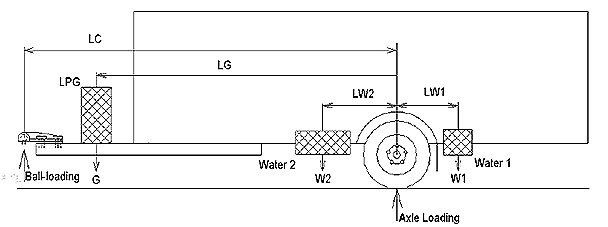CARAVAN manufacturers are putting caravanners at risk with improperly
located water tanks, it has been claimed.
The Caravan Council of Australia cites one "shocking example" of a design
which, it said, could seriously affect the handling and stability of the
RV (see photo above).
"It makes you wonder how many caravans like this are on the road and in
the hands of unwary owners," CCA founder and qualified automotive engineer
Colin Young told Caravanning News.
He said a recent ball-loading survey raised a common question ... how much
do full or empty water tanks change the ball-loading.
"A number of 'vans have been built with two water tanks, with some
positioned a long way ahead or behind the axles," Mr Young explained.
"This causes the ball-loading to vary appreciably depending on whether
each tank is empty or full, often resulting in handling and stability
problems.
"There is the possibly of exceeding the down-load rating of the
tow-vehicle or tow-bar."
Mr Young has provided a simple drawing and formula for calculating the
change in ball-loading.
"Knowing what this change is enables the caravanner to load the 'van
correctly so as to achieve the ball-loading recommended by the
manufacturer," he said.
Note: Dimensions from the centre of the axle-group to the left are
positive, dimensions to the right are negative.
When containing water/LPG, tanks ahead of the axle(s) increase the
ball-loading; tanks behind of the axle(s) decrease the ball-loading.
The Actual Mass of the 'van will increase by: G + W1 + W2 when the empty
tanks are filled. One litre of water weighs one kilogram.
If a third tank is fitted, add it to the drawing and measure the (+ or -)
distance from the centre of the tank to the centre of the axle(s).
Calculate the 'Moments' – Mass x Distance – around the centre of the axle
(or midway between tandem axles).
Change in ball-loading = ( (G x LG) + (W2 x LW2) - (W1 x LW1) ) / LC.
Example: G = 18kg; W1 = 45kg; W2 = 90kg; LG = 3m; LW1 = 1.5m; LW2 = 1.5m;
LC = 3.5m
Change in ball-loading = ( (18 x 3) + (90 x 1.5) - (45 x 1.5) ) / 3.5.
Change in ball-loading = ( (54) + (135) - (67) ) / 3.5
Change in ball-loading = ( 122 ) / 3.5
Change in ball-loading = + 35 kg
Worst Case 1: W1 empty; G & W2 full
Change in ball-loading = + 54kg
Worst Case 2: W1 full; G & W2 empty
Change in ball-loading = - 19kg
Caravans should be designed so that there is the least possible change in
the ball-loading, when each tank is full or empty.
Multiple water tanks should be positioned as close as possible to, and
each side (front/rear) of the axle(s).
The formula can also be used to calculate the change in ball-loading when
an appliance, or heavy article, is installed.








